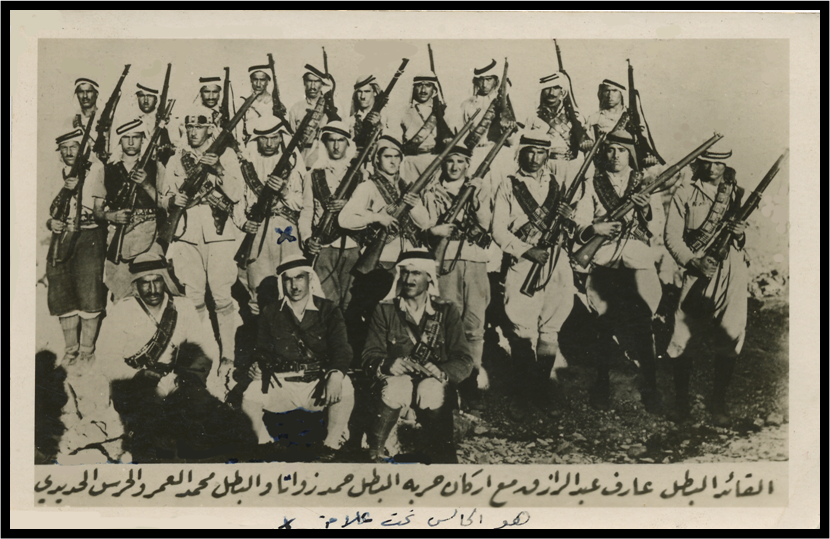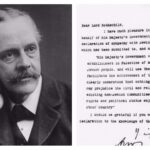It is the great Palestinian revolution that began on April 20, 1936 and extended until 1939. It is distinguished from the revolutions that took place between 1920 and 1933, as all that was known as Palestinian revolutions before the 1936 revolution were nothing more than uprisings or uprisings. As for the 1936 revolution, it had The conditions of the revolution as a goal, a tool, and a method, and it represents a prominent milestone in the Palestinian national struggle movement against Zionism and British colonialism since the late nineteenth century. It is a qualitative shift in the directions of this struggle after the general state of weakness that befell the Palestinian national movement in the wake of the Buraq uprising in 1929).
The 1936 revolution began in an almost spontaneous manner and quickly polarized the people in an unprecedented way, with the goals of stopping Jewish immigration, preventing the sale of land, assassinating land sellers, brokers, and spies, confronting the partition project that Britain was preparing to implement, preserving the Arab identity of Palestine, preserving its lands, preventing its Judaization, and declaring its independence. In comprehensive Arab unity.
The revolution resorted to armed struggle as a method to extract its rights from British colonialism, and it did not stop until the outbreak of World War II in 1939, for personal reasons, and reasons related to the official Arab intervention to end the strike, and the Franco-British alliance on the eve of 1939.
Factors for the outbreak of the revolution:
The Palestinian leadership was forced to resort to revolution as the people’s only option as a result of developments in events after the Buraq uprising of 1929. These developments and events constituted a great threat to the Arab presence in Palestine politically, economically and socially. Among these developments are the following:
* The traditional leadership and institutions that led to the weakness of the Palestinian national movement, especially after the death of the Chairman of the Executive Committee, Musa Kazem Al-Husseini, the dissolution of the committee, and the initiation of the “leadership through parties” experiment, which was a new manifestation of tribalism and political feudalism, and this was helped by the policy of the new British High Commissioner, Wahoob. .
* Sheikh Izz al-Din al-Qassam Revolution of 1935: It embodied the belief in the futility of political action and that armed action is the only way to achieve national goals. This revolution awakened the Palestinian people and ignited in them enthusiasm for jihad.
* National and Arab nationalist movements: represented by Iraq gaining semi-independence with the 1930 treaty that abolished the mandate, Egypt’s unrest demanding the restoration of the constitution in 1923, and the Syrian strike in 1936 with the aim of abolishing the mandate.
* The increasing numbers of Jewish immigration: On the eve of the 1936 Revolution, it reached about 40 thousand immigrants, and the continuation of secret immigration to Palestine with the British government ignoring, covering up and protecting it, and the British House of Commons rejecting the Arabs’ demand to stop Jewish immigration in March 1936. *
Takeover The Zionists occupied the Palestinian lands and the enactment of regulations and laws by the British government to facilitate the process of seizing lands and displacing peasants and turning them into workers suffering from unemployment. As the working class increased with the peasants who were stripped of their lands and could not find work, unemployment became widespread, and its severity was compounded by the “Hebrew labor principle” and “ownership of work” adopted by the Zionists, and the preference of the British authorities to obligate work to Zionist contractors even in some areas. Arabic, the low wages of Arab workers compared to Zionist workers in one profession, and the rise in taxes on land ownership from 9% to 15%, while the farmer used to pay 25% of his net income in taxes in the lean years.
* The growth of the military situation of the Zionists: The Haganah was reorganized after the Buraq uprising, in terms of numbers and expansion of missions, aggression by settlers against neighboring cities and villages, committing criminal terrorist acts against Arabs, and secretly manufacturing and importing weapons in large quantities and distributing them to Zionist cities and colonies. .
The general strike and declaration of revolution:
In this tense atmosphere, the spark that ignited the revolution occurred. On April 15, 1936, near Anabta between Tulkarm and Nablus, an armed group killed two Jews and wounded a third, who were on their way to Tel Aviv. The next day, two Arabs were killed by the Haganah in Biyara near Jaffa, and tension intensified in the Jaffa area. – Tel Aviv. Violent clashes occurred between Arabs and Jews, especially in mixed neighborhoods. Dozens of homes and shops were burned, and a Jew was killed and about fifty wounded. After three days of clashes, the British government took control of the situation and imposed a curfew on the two cities and their surroundings and declared a state of emergency in the country. Jaffa declared a general strike, and the cities and villages of Palestine followed suit. The leaders of the cities and villages of all walks of life and groups took the initiative to establish national committees, and these committees included representatives of all parties and sects. And categories.
On April 25 – while the general strike was still ongoing – the national committees held a general conference in Jerusalem, and this conference decided to form a central leadership for the national movement based in Jerusalem. It consisted of the “Arab Higher Committee for Palestine,” headed by Amin Al-Husseini and with the membership of representatives of all Palestinian parties. and representatives of the independents, and the “Arab Higher Committee” took the following decision and announced it to the people: “Calling on the Palestinian Arab people to continue the general strike until the British government changes its policy and changes its positions, and that the first indication for this change should be the cessation of Jewish immigration to Palestine. It was agreed that it would be delayed.” Declaring an armed revolution for some time and focusing efforts on the strike and its continuation.
Despite the intensification of the strike, Britain rejected the Arabs’ request to stop Jewish immigration as announced by the Arab Higher Committee for Palestine, and challenged them by issuing a new immigration certificate that it presented to the Jewish Agency to bring large numbers of immigrants to Palestine
. With this challenge, the Palestinian leaders decided to declare an armed revolution, and in implementation of this decision, the “Holy Jihad Army” announced the armed revolution against the enemies (consisting of all secret military formations and organizations and those who joined them later, and Abdul Qadir al-Husseini was chosen to lead it) and the Mujahideen began attacking the army and police barracks and the colonies. Judaism, destroying transportation routes and attacking enemy convoys and gatherings. In its first four days, the actions of the revolution were limited to the Jerusalem Brigade alone, but on the fifth day it spread throughout Palestine in cities, villages, and the desert.
The operations initially began in the cities and spread throughout them, as they spread to Jaffa, Nablus, Jerusalem, Tiberias, Haifa, and Safed. They provoked the occupation forces in the cities, which became in constant clashes with the fighting cells and focused their activity in Nablus, Jerusalem, and Jaffa, where the revolutionary cells were active, so they mobilized large forces for them. From the army, as a result, the revolutionaries moved to the countryside and joined the revolutionary groups that were working there. These groups were not unified, and among them was the Al-Qassam organization, such as Farhan Al-Saadi, who worked in the Jenin area and was arrested in the village of Nawras and executed when he was seventy-five years old in 1937. And dozens of other local groups worked to form an armed group in every village and city.
A development occurred on the field with the entry of Fawzi al-Qawuqji and his forces into the Triangle area. Volunteers from Jordan, Syria and Lebanon poured in and joined the holy jihad. As a result, the revolution in its third month turned into open battles with British forces throughout Palestine.
The resistance targeted public transport and wire communications, blocked roads, blew up bridges and railway lines, as well as the oil pipeline between Iraq and Haifa. Secret groups inside the cities began assassinating British employees, army and police officers, spies, land sellers and brokers, and throwing explosives at government departments. The revolutionaries achieved victories in many battles and became These attacks are a familiar phenomenon in the “Triangle of Terror,” as the British soldiers called it, referring to the area between Nablus, Jenin, and Tulkarm. Major battles also took place in Marj Ibn Amer, Wadi Azoun, and Baba al-Wad, in which many martyrs and British soldiers fell.
The revolution proved to be resistant to military crushing and showed the ability to fight. Acts of violence and repression strengthened the spirit of resistance and increased the numbers of those affiliated with it. On the other hand, the Mandate government took military measures to suppress the revolution and imposed heavy fines, collective punishments, and death penalties. It arrested many people, vandalized property, blew up homes, and demolished the neighborhood. The old city of Jaffa…etc. Despite all this, it could not suppress the popular revolution.
Stopping the strike:
Britain felt unable to stop the revolution and end the strike by military means, so it resorted to extremely devious methods and announced that it had decided to send a royal commission to investigate the Palestinian issue and the people’s complaints, and to make recommendations to resolve the issue in a just manner. Britain mediated with some Arab rulers to persuade the Palestinians to stop the revolution, and some of them came to Palestine to find great determination to continue the revolution until their demands were met.
Nour Al-Saeed from Iraq was moving on this issue, as were Prince Abdullah and Prince Saud. Contacts were renewed between the Arab leaders and the higher commands, but to no avail. In the end, Britain brought in additional forces to crush the resistance, as the number of British forces reached in the first half of August 1936. There are 70,000 soldiers in Palestine, in addition to about forty thousand regular and additional police forces, the Trans-Jordan Border Force, the Jewish Colonial Guard, the Haganah forces, and the Zionist secret terrorist organizations.
Despite this, these efforts failed and were in vain, and the revolution continued to burn throughout the months of August and September 1936, without appeasement or weakness. But after contacts and consultations conducted by the Arab kings and presidents at the request of Britain to intervene to end the strike, they sent a message to the head of the Arab Higher Committee for Palestine to end the strike and end the resistance. The Palestinians responded to the calls of the Arab leaders and stopped the strike and revolution on 10/13/1936, which was the pretext for the Palestinian leadership to agree to end the strike. It is olive harvest season.
Royal Commission “Peel Commission”:
The morning of October 12, 1936 was the end of the great strike, and the people returned to their normal lives without the leadership receiving any promise. The Royal Commission of Inquiry came to Palestine before the end of 1936 to present its recommendations. The Palestinian leadership refused to meet with the committee, but under Arab pressure from Egypt and Saudi Arabia and some threats, the leadership agreed to receive the committee.
The Royal Commission completed its work in late January 1937 and returned to London. It indicated in late June 1937 that it recommended dividing Palestine into three regions: an Arab region, a British region, namely Jerusalem, and a Jewish region. This project was rejected by the Zionist movement because it did not serve its interests. The Palestinian leadership also rejected it, and the Arab leadership adhered to the position of the Palestinian leadership, except for Prince Abdullah. The Palestinian leadership announced a statement to the people calling on them to adhere to national demands and resist partition. At the beginning of July 1937, loud demonstrations against partition took place in Palestine and bloody clashes took place between Arabs and enemies.
An order was issued to arrest Amin Al-Husseini as he was responsible for igniting the revolution. Al-Husseini took refuge in Al-Aqsa, and in the end he fled from Al-Aqsa in disguise to Lebanon. After a period of time after his arrival in Lebanon, he was able to publish a statement in the Arab newspapers in which he affirmed his rejection of the partition plan and his adherence to the well-known demands of the people, and called for resistance. British policy and to fight the partition project until it was eliminated. The Palestinians considered this statement a call for armed revolution, and thus the revolution was resumed and huge battles took place until it was eliminated. The Palestinians considered this statement a call for armed revolution, and thus the revolution was resumed and huge battles took place that took on a military nature. The Mujahideen carried out attacks. They were organized over cities and were able to occupy some of them and raise the Palestinian flag in them, including: Hebron, Bethlehem, Al-Falujah, Old Jerusalem, Acre, Beit Sahour, Al-Majdal and Beersheba. They did not leave it until after fierce battles with the British forces, and at this stage the attacks on the Zionist colonies expanded, causing them heavy material losses.
During this period, the military action was precise and organized, so that at first a new committee was formed, called the Arab Committee for Jihad. The regions were divided into sections, and each region had its own leader, and the revolutionaries became masters of the situation.
The Round Table Conference:
During this period, Britain was preoccupied with its own affairs and needed relative calm in Palestine, so after its inability to eliminate the revolution, it was forced to reverse the partition decisions. The Round Table Conference was held to discuss reaching a solution to the Palestine issue, and it was agreed that the Palestinians would be represented in The conference represented representatives of the “Arab Higher Committee” on the condition that they were from within, and allowed to consult with the outside. The delegation traveled to Cairo and they agreed on the principles on which the delegation would be based.
The Round Table Conference was held, but the British did not succeed in bringing the Arabs and Zionists together. Contacts were made with each party separately, but to no avail.
In 1939: The rate of Palestinian battles against the occupation declined, as the initiative slipped away from the revolutionaries and passed into the hands of the British forces, which moved with the Zionist organizations to the site of the attack, disarming the revolutionaries and shaking their organizations, and their lack of effective military and political leadership capable of challenging the superiority of the opponent. The military leadership did not It is considered to exist internally in actual terms, especially after the martyrdom of Commander-in-Chief Abd al-Rahim al-Haj Muhammad in March 1939, and the presence of Abd al-Qadir al-Husseini outside the country since he was injured in the fall of 1938, and this was accompanied by the absence of a military strategy and the lack of effective capabilities in addition to the unsuitability of the international situation. Given the dominance colonialism represented over international relations in that period and the self-interested alliances that began to form on the eve of World War II.
One of the important results of the revolution is that it exposed the local and Arab leaders who interfered in the Palestine issue in a way that contributed to aborting the revolution, in addition to exposing the imperialist-Zionist alliance in the region and providing a model for liberation, defending the homeland, and preserving an Arab Palestine.


